Grace Elliot's Blog: 'Familiar Felines.' , page 32
April 14, 2011
5/5 Top Pick review from Night Owl Reviews!!
Yeah! I'm bouncing round the room after reading this awesome review for "A Dead Man's Debt."
http://www.nightowlreviews.com/nor/Reviews/Noelle-reviews-A-Dead-Mans-Debt-by-Grace-Elliot.aspx
Review:
> I honestly have to say that this story surprised me on nearly every turn. Just when I thought I had the storyline predicted that I knew what was going to happen next, Ms. Elliot changed it up on me, and it was wonderful! At first glance, this is a story that has been written a thousand times. Dissolute wastrel reformed by an innocent, spirited girl, skeletons in the closet keeping them from their ultimate happiness, but the bravery of our reformed hero saves the day. This story starts on that track, but then avoids predictability by doing the unexpected. I loved it!
> Celeste and Ranulf were excellent characters. Ranulf is your typical society rake with a secret talent. On the surface, he is totally fixated on the fairer sex, but he is burdened with issues that truly show the depth of his character behind the mask. However, as we get to know him better, we are given glimpses into his past, and elements in his private life that show him to be a truly noble hero, even willing to sacrifice his own life to save the woman he loves. Celeste was his perfect match, a woman who was not afraid to take life by the horns and live it for all it was worth, but who had her own issues to deal with. Already burned by one society rake, she is reluctant to trust Ranulf or her attraction to him.
> Our villain in this story also avoids the trap of predictability. On first glance, it seems to be a case of been there, read that, but surprise! It isn't that way at all! Without giving away all the good parts, it was wonderful to read a story where the heroine tried to save the hero, but was sensible about it.
> Will Celeste and Ranulf be able to work through their issues, or will the danger hovering in the background swallow their new love? Will Celeste realize that she can trust Ranulf with everything, even her tender heart? You will have fun finding out!
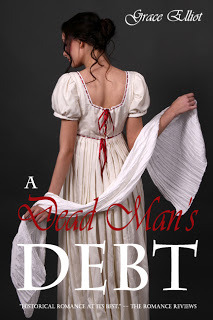

http://www.nightowlreviews.com/nor/Reviews/Noelle-reviews-A-Dead-Mans-Debt-by-Grace-Elliot.aspx
Review:
> I honestly have to say that this story surprised me on nearly every turn. Just when I thought I had the storyline predicted that I knew what was going to happen next, Ms. Elliot changed it up on me, and it was wonderful! At first glance, this is a story that has been written a thousand times. Dissolute wastrel reformed by an innocent, spirited girl, skeletons in the closet keeping them from their ultimate happiness, but the bravery of our reformed hero saves the day. This story starts on that track, but then avoids predictability by doing the unexpected. I loved it!
> Celeste and Ranulf were excellent characters. Ranulf is your typical society rake with a secret talent. On the surface, he is totally fixated on the fairer sex, but he is burdened with issues that truly show the depth of his character behind the mask. However, as we get to know him better, we are given glimpses into his past, and elements in his private life that show him to be a truly noble hero, even willing to sacrifice his own life to save the woman he loves. Celeste was his perfect match, a woman who was not afraid to take life by the horns and live it for all it was worth, but who had her own issues to deal with. Already burned by one society rake, she is reluctant to trust Ranulf or her attraction to him.
> Our villain in this story also avoids the trap of predictability. On first glance, it seems to be a case of been there, read that, but surprise! It isn't that way at all! Without giving away all the good parts, it was wonderful to read a story where the heroine tried to save the hero, but was sensible about it.
> Will Celeste and Ranulf be able to work through their issues, or will the danger hovering in the background swallow their new love? Will Celeste realize that she can trust Ranulf with everything, even her tender heart? You will have fun finding out!

Published on April 14, 2011 06:40
April 13, 2011
Something to Make You Smile!
A bit of fun this week courtesy of fellow Solstice author, James Hatch.
Thank you James, x.







A big thank you to James Hatch, author of 'The Substitute,' for providing the pictures.
Thank you James, x.







A big thank you to James Hatch, author of 'The Substitute,' for providing the pictures.
Published on April 13, 2011 10:14
April 10, 2011
Gathered by Virgins - part 2.
The ritual of tea drinking, plus how to brew the perfect cupper.
Continuing on from my midweek post about the unusual side of tea drinking, let us know consider the English ritual of tea drinking.
By the 1880's tea drinking became an upper class ritual. Ladies gathering around a silver tea pot with elegant porcelain cups became symbols of good taste and refinement and the preparation of tea was an art in itself. A popular household manual from the 1880's 'Enquire With Upon Everything' instructs on how to make the perfect brew.
- Use freshly boiled water, not exhausted by prolonged boiling- Scald the pot with hot water then empty it- Add sufficient water and then add the tea, quickly closing the lid- Let the brew stand for three and a half minutes- This greatly superior method preserves the delicate aroma of the tea.
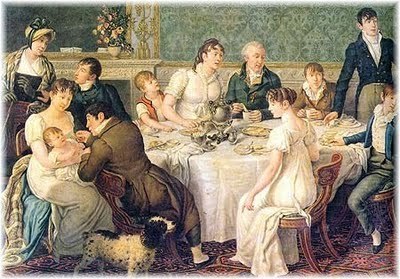 A regency tea party.
A regency tea party.
Other help words on making tea include:
- A given quantity of tea imparts strength to the water; any additional quantity is a waste.- Two small teaspoons of good black tea are sufficient for three cupfuls.- The best tea is made with the best water; too hard or soft will yield quantities of black tannin.- Dr Kitchiner recommends all water pouring in one drawing, a second drawing is bad. Better to have two teapots than two drawings.
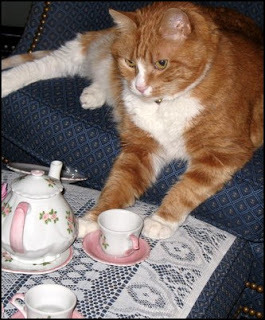
All this takes me back to my grandmother and her insistance on the correct manner of making tea. I understand a bit better now where she was coming from and almost feel guilty about dunking a lonely tea bag in a mug of hot water. How about you? Does your family have rituals attached to making tea? Indeed, do you drink tea at all or has coffee drinking taken over?


Continuing on from my midweek post about the unusual side of tea drinking, let us know consider the English ritual of tea drinking.

By the 1880's tea drinking became an upper class ritual. Ladies gathering around a silver tea pot with elegant porcelain cups became symbols of good taste and refinement and the preparation of tea was an art in itself. A popular household manual from the 1880's 'Enquire With Upon Everything' instructs on how to make the perfect brew.
- Use freshly boiled water, not exhausted by prolonged boiling- Scald the pot with hot water then empty it- Add sufficient water and then add the tea, quickly closing the lid- Let the brew stand for three and a half minutes- This greatly superior method preserves the delicate aroma of the tea.
 A regency tea party.
A regency tea party.Other help words on making tea include:
- A given quantity of tea imparts strength to the water; any additional quantity is a waste.- Two small teaspoons of good black tea are sufficient for three cupfuls.- The best tea is made with the best water; too hard or soft will yield quantities of black tannin.- Dr Kitchiner recommends all water pouring in one drawing, a second drawing is bad. Better to have two teapots than two drawings.

All this takes me back to my grandmother and her insistance on the correct manner of making tea. I understand a bit better now where she was coming from and almost feel guilty about dunking a lonely tea bag in a mug of hot water. How about you? Does your family have rituals attached to making tea? Indeed, do you drink tea at all or has coffee drinking taken over?

Published on April 10, 2011 10:49
April 8, 2011
Is There a Stigma in Reading Romance?
Grace visits the Book Wenches and asks: Is there a stigma attached to reading romance?
I think so. It is only since becoming a published author of historical romance that I 'came out' and admitted to reading the genre. The strange thing is that since I went public, people I consider perfectly normal, intelligent, fulfilled and responsible, who I never previously suspected of being fellow addicts, also came out and said; 'Oh yeah, I love reading romance to.' So why this reluctance to go public?
http://www.bookwenches.com/gbloggraceelliot.htm
So what do you think?
Are you secretive about your romance habit, and if so, why?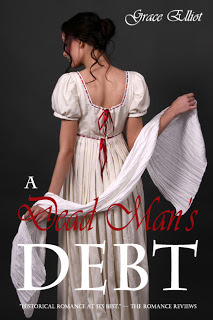

I think so. It is only since becoming a published author of historical romance that I 'came out' and admitted to reading the genre. The strange thing is that since I went public, people I consider perfectly normal, intelligent, fulfilled and responsible, who I never previously suspected of being fellow addicts, also came out and said; 'Oh yeah, I love reading romance to.' So why this reluctance to go public?
http://www.bookwenches.com/gbloggraceelliot.htm
So what do you think?
Are you secretive about your romance habit, and if so, why?

Published on April 08, 2011 12:44
April 6, 2011
Gathered by Virgins.

There's something about a good cup of tea that lubricates thought and helps the day go more smoothly. My parents drink tea by the bucket full, whereas I mainly drink it at work. There are cultural differences to; I believe tea is much less popular in America than it is here in the UK, but strangely the Portuguese and Dutch are big tea drinkers. Anyhow, when tea was first introduced to Britain in the mid 17th century, wild claims about its health benefits ensured its popularity. In 1657 Thomas Garway, proprietor of a coffee house in Exchange Alley in London claimed tea was "gathered by virgins" and "makes a body active and lusty". This miracle elixir also; "preserves perfect health until extreme old age", "vanquishes nightmares" and "dispenses with the need for sleep."
 King Charles II.When the court of Charles II, influenced by his Portuguese wife Catherine of Braganza, started drinking tea its popularity rose to the point of a drop in alcohol consumption amongst the masses. This had the knock on effect of lowering revenue from alcohol sales and so government quickly increased the tax on tea (reaching a peek in the mid 1750's when it stood at over 100%.) One concern Charles II had was that tea drinking encouraged small groups to assemble over a brew and increased opportunities for seditious plotting. So in 1675 Charles forbad the sales of tea to private houses. Such was the outrage that he was forced to revoke the law within a week of its issue.
King Charles II.When the court of Charles II, influenced by his Portuguese wife Catherine of Braganza, started drinking tea its popularity rose to the point of a drop in alcohol consumption amongst the masses. This had the knock on effect of lowering revenue from alcohol sales and so government quickly increased the tax on tea (reaching a peek in the mid 1750's when it stood at over 100%.) One concern Charles II had was that tea drinking encouraged small groups to assemble over a brew and increased opportunities for seditious plotting. So in 1675 Charles forbad the sales of tea to private houses. Such was the outrage that he was forced to revoke the law within a week of its issue.  The Cutty Sark in full sail.The market to tea was huge and the profits for those importing were immense. The East India Company recognized this and rapidly monopolized the sea trade with its fleet of tea clippers such as the Cutty Sark. The streamlined, tall masted sailing vessels could reach speeds of nearly 18 knots, which was extraordinary at the time.
The Cutty Sark in full sail.The market to tea was huge and the profits for those importing were immense. The East India Company recognized this and rapidly monopolized the sea trade with its fleet of tea clippers such as the Cutty Sark. The streamlined, tall masted sailing vessels could reach speeds of nearly 18 knots, which was extraordinary at the time.  Charles Harrod was a tea wholesaler before he opened his famous shop. But when in the late 1700's tax made the price of tea prohibitive to many people, there were unscrupulous traders who 'cut' tea with sloe leaves, liquorice and even the dried dregs from tea pots. It took action by William Pitt the Younger in 1784 to recognize what was happening and save the quality of the great British cupper. He reduced the tax on tea to 12.5% and a year later brought in the 'Food and Drug Act' which promoted harsh penalties for adulterating tea. However it wasn't until well over a century later in 1879 that someone thought to inspect tea at the site of import to ensure purity.
Charles Harrod was a tea wholesaler before he opened his famous shop. But when in the late 1700's tax made the price of tea prohibitive to many people, there were unscrupulous traders who 'cut' tea with sloe leaves, liquorice and even the dried dregs from tea pots. It took action by William Pitt the Younger in 1784 to recognize what was happening and save the quality of the great British cupper. He reduced the tax on tea to 12.5% and a year later brought in the 'Food and Drug Act' which promoted harsh penalties for adulterating tea. However it wasn't until well over a century later in 1879 that someone thought to inspect tea at the site of import to ensure purity. NEXT POST (Sunday)– The ritual of tea drinking, plus how to brew the perfect cupper.

Published on April 06, 2011 12:38
April 3, 2011
Enlightening Thoughts.

My weekend blog post starts with a question:
Which of the following was used as a lightning conductor?A – Growing the plant 'House Leek' in the gardenB - Wearing a crown of laurels during a thunderstorm.C - An iron pole connected to the ground via a metal strip.D - Ringing church bells.E - Having a 'Witch post' near the main door. ANSWER: The correct answer is C, but surprisingly A, B, C, D and E have all been used as protection against lightning!
 The Roman Emperor Tiberius.It was the Emperor Tiberius who reached for a laurel crown as he believed it gave him immunity from lightning strike. Fair enough, he never was struck by lightning but I suspect he probably didn't go standing on any hill tops either!
The Roman Emperor Tiberius.It was the Emperor Tiberius who reached for a laurel crown as he believed it gave him immunity from lightning strike. Fair enough, he never was struck by lightning but I suspect he probably didn't go standing on any hill tops either! The succulent plant, 'House Leek.' In Medieval Britain, the people of the Forest of Dean held that planting 'House Leek' in the garden diverted lightning from the thatched roofs of their cottages – worth a try I suppose. And on the same theme of diverting lightning, five hundred years ago in Stangend, North Yorkshire, a farmer came up with the ingenious idea of a 'Witches post' carved with the St. Andrews cross so that evil spirits and malign influences could go no further.
The succulent plant, 'House Leek.' In Medieval Britain, the people of the Forest of Dean held that planting 'House Leek' in the garden diverted lightning from the thatched roofs of their cottages – worth a try I suppose. And on the same theme of diverting lightning, five hundred years ago in Stangend, North Yorkshire, a farmer came up with the ingenious idea of a 'Witches post' carved with the St. Andrews cross so that evil spirits and malign influences could go no further.  Lightening was especially worrying when your house had a thatched roof. Whereas house leek and witches posts did no harm, one tradition in 18th century Europe was positively dangerous. It was the habit in parts of Germany for villagers to ring the church bells during a storm, in order to disperse lightning. Of course with church steeples being the highest points for miles around, and bells being made of metal, there was a high mortality rate amongst bell ringers. Indeed in 1784 a study was undertaken in Munich, when it was realized that 386 church towers had been struck and 103 bell ringers died.
Lightening was especially worrying when your house had a thatched roof. Whereas house leek and witches posts did no harm, one tradition in 18th century Europe was positively dangerous. It was the habit in parts of Germany for villagers to ring the church bells during a storm, in order to disperse lightning. Of course with church steeples being the highest points for miles around, and bells being made of metal, there was a high mortality rate amongst bell ringers. Indeed in 1784 a study was undertaken in Munich, when it was realized that 386 church towers had been struck and 103 bell ringers died. 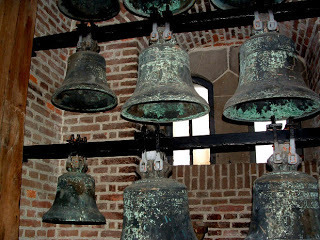 It took Benjamin Franklin, in 1766 to come up with a solution. He proposed mounting iron rods on high roofs; connect to the ground via metal strips. This was tried with resounding success on the 100m tall bell tower of St Mark's in Venice, which had been struck 9 times…after the installation of the first lightning conductor no serious damage was done.
It took Benjamin Franklin, in 1766 to come up with a solution. He proposed mounting iron rods on high roofs; connect to the ground via metal strips. This was tried with resounding success on the 100m tall bell tower of St Mark's in Venice, which had been struck 9 times…after the installation of the first lightning conductor no serious damage was done. 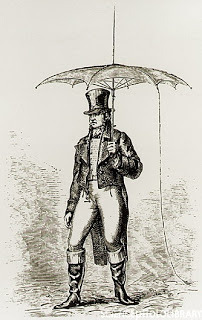 But finally, it seems prejudice overcame common sense when it came to the Georgian Royal Navy. King George III failed to believe any good ideas could come out of the rebellious American colonies and so refused to have lightning conductors fitted to Royal Naval ships. This resulted in the loss of 200 ships to lightening during the Napoleonic wars alone. (The Navy relented in 1830, by which time such conductors were in common use on towers on land.)
But finally, it seems prejudice overcame common sense when it came to the Georgian Royal Navy. King George III failed to believe any good ideas could come out of the rebellious American colonies and so refused to have lightning conductors fitted to Royal Naval ships. This resulted in the loss of 200 ships to lightening during the Napoleonic wars alone. (The Navy relented in 1830, by which time such conductors were in common use on towers on land.) 
Published on April 03, 2011 12:08
March 30, 2011
Taking the P**s - The Strange History of Urine.
 Aristotle - sporting a fine head of hair. Following on from last week's post on "Toilets and Timid Women" I thought I'd write about the positive side of urine. For centuries people have used urine for its medicinal purpose – I kid you not! August people such as Pliny (the Roman author) advocated treating burns, ear pus and head sores with urine, whilst Aristotle, (the Greek philosopher) reportedly rubbed urine into his scalp as a treatment for baldness. (Perhaps it helped his baldness, but did it make him any friends?).
Aristotle - sporting a fine head of hair. Following on from last week's post on "Toilets and Timid Women" I thought I'd write about the positive side of urine. For centuries people have used urine for its medicinal purpose – I kid you not! August people such as Pliny (the Roman author) advocated treating burns, ear pus and head sores with urine, whilst Aristotle, (the Greek philosopher) reportedly rubbed urine into his scalp as a treatment for baldness. (Perhaps it helped his baldness, but did it make him any friends?). Marcius Cato - was the smell of urine causing him to pull this face? The Roman senator and soldier, Marcius Cato even prescribed eating cabbage, to make superior, health giving urine since apparently cabbage, "Surpasses all other vegetables". Cato even advises "Bathe a baby in it [cabbage derived urine] and the child will never be weakly"
Marcius Cato - was the smell of urine causing him to pull this face? The Roman senator and soldier, Marcius Cato even prescribed eating cabbage, to make superior, health giving urine since apparently cabbage, "Surpasses all other vegetables". Cato even advises "Bathe a baby in it [cabbage derived urine] and the child will never be weakly"
 And"Splash your eyes with it and you will see better."
And"Splash your eyes with it and you will see better."There are countless stories of urine being used to treat infections, skin sores and clean teeth, but this is actually not as mad as it sounds. Take for instance the troops in the trenches during World War I. It was noticed that soldiers who urinated once a day on cuts and scratches, were less likely to develop infected wounds. This backs up work by a 1906 pathologist, W James Wilson, who demonstrated that, the main constituent of urine, urea, inhibits bacterial growth. During the 20th century scientific studies continued and even as recently as 1992, doctors at the Royal Free Hospital, London, showed urea has definite anti-itch properties and can be used to help skin conditions such as eczema and psoriasis.
 Which leads us nicely onto today's conversation point. Urea is widely used in the modern cosmetics industry. Urea is an excellent skin moisturizer; it binds water, minimizes loss and plumps up skin. The synthetic version of urea, carbamide, is a constituent of most skin creams, foundations, cleansers, shampoos and hair conditioners. So the question is: which do you prefer – A nice pot of scented moisturizer, or a bottle of stale urine…. (Not a trick question by the way!) Does it make you look afresh at your skin products?
Which leads us nicely onto today's conversation point. Urea is widely used in the modern cosmetics industry. Urea is an excellent skin moisturizer; it binds water, minimizes loss and plumps up skin. The synthetic version of urea, carbamide, is a constituent of most skin creams, foundations, cleansers, shampoos and hair conditioners. So the question is: which do you prefer – A nice pot of scented moisturizer, or a bottle of stale urine…. (Not a trick question by the way!) Does it make you look afresh at your skin products?
Published on March 30, 2011 12:23
March 27, 2011
Toilets and Timid Women.

Now as you might have gathered, I'm a fan of the Regency. However…and it's a big but…I wouldn't want to live there. The reason (or one of them…) the lack of flushing plumbing! I couldn't be doing with chamber pots, closed stools and ceespits…give me u-bends and Armitage-Shanks every time.I suspect I'm not alone in this, and neither, so it seems, am I alone in the confusion over what to call a toilet. Apparently there is a world wide reticence to say the word 'toilet' or 'lavatory' in public.
I love this story of an English lady in the 1930's, who was accosted at a party by a drunken man, wanting to know where the toilet was. Her icy reply was;'On the left of the entrance hall you will find a door marked 'Gentlemen'. Disregard the warning, go right in and you'll find what you want.'
 In England the reluctance to say the word toilet, led to a litany of euphemisms including;WC (water closed), bog, jakes, loo, powder room, heads and convenience. In the early 20th century the more polite amongst us might have asked about "the geography of the house"Or"To use the cloak room"And this shyness is nothing new. There is a biblical reference to "the place where one cover's one's feet" and in 1653 Richard Codrington wrote in 'The Mirror of History' of "the stool of easement". The Danes, almost poetically ask for "The place where the King goes alone," and in a similar vien the French for "Where the king goes on foot."
In England the reluctance to say the word toilet, led to a litany of euphemisms including;WC (water closed), bog, jakes, loo, powder room, heads and convenience. In the early 20th century the more polite amongst us might have asked about "the geography of the house"Or"To use the cloak room"And this shyness is nothing new. There is a biblical reference to "the place where one cover's one's feet" and in 1653 Richard Codrington wrote in 'The Mirror of History' of "the stool of easement". The Danes, almost poetically ask for "The place where the King goes alone," and in a similar vien the French for "Where the king goes on foot." A Stone Toilet.In Wales it was the 'ty back' or 'little house', in reference to an outside privy. Indeed, one American entrepreneur, Lem Putt, who became known as 'the champion privy builder of Sangamon County' had theis sage advice about where to site an outside toilet."Put her in a straight line with the house, past the wood pile. I'll tell you why. Take a timid woman; if she sees any men folk around, she's too bashful to go direct out so she'll go to the woodpile, pick up wood and go back to the house. On a good day you'll have the wood box filled by noon."
A Stone Toilet.In Wales it was the 'ty back' or 'little house', in reference to an outside privy. Indeed, one American entrepreneur, Lem Putt, who became known as 'the champion privy builder of Sangamon County' had theis sage advice about where to site an outside toilet."Put her in a straight line with the house, past the wood pile. I'll tell you why. Take a timid woman; if she sees any men folk around, she's too bashful to go direct out so she'll go to the woodpile, pick up wood and go back to the house. On a good day you'll have the wood box filled by noon."Yep, indoor six inch diameter, flushing plumbing every time please!

Published on March 27, 2011 11:58
March 23, 2011
A Fashion for Bad Language.
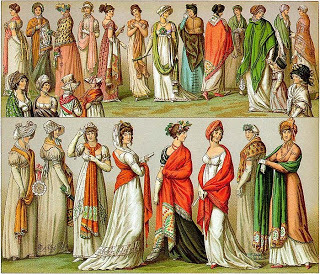 Elegant costumes...but not elegant language.I don't know about you, but I find women swearing somehow much more offensive than men. Perhaps it's because women are the gentler sex and discouraged from testosterone driven competitiveness, but surprisingly, in the 18th Century it seems bad language was tolerated from women. As one observer in the 1700's wrote;
Elegant costumes...but not elegant language.I don't know about you, but I find women swearing somehow much more offensive than men. Perhaps it's because women are the gentler sex and discouraged from testosterone driven competitiveness, but surprisingly, in the 18th Century it seems bad language was tolerated from women. As one observer in the 1700's wrote;"Good round oaths are often heard from the lips of gentlewomen, who are quite familiar with the slang of the sportsmen and the stable."
And rank was no bar as shown in this story about the Duchess of Marlborough.
One day the Duchess called on the Chief Justice Lord Mansfield, but neglected to leave her name. When his Lordship queried the manservant who had answered the door, as to who had called, the bemused footman's reply was;"I couldn't find out who she was, my Lord, but she swore so stiff she must be a lady of quality."
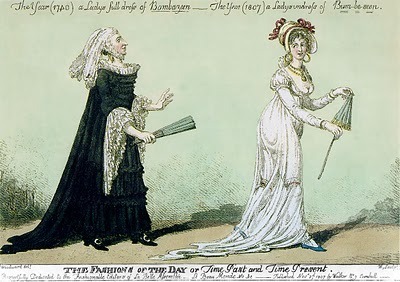 The fashion for Bomabzine...or 'Bum-be-seen.'
The fashion for Bomabzine...or 'Bum-be-seen.'Does it bother you when women swear? Is it unforgiveable or excusable in certain situations, or is swearing not worth getting upset about? Share your thoughts (no obscenities please!) in the comments below.
Published on March 23, 2011 09:26
March 20, 2011
How to Kiss...and Other Musings.

"A lover should not hold his bride by the ears in kissing her..." Henry Theophilus Finck. 1887
Kissing is not, as you might suppose, something that has happened since the evolution of man. Instead the historian St Pierius Wensemius claims it was 'invented' by a Friesian Princess. According to Wensemius kissing was;
"Unpracticed and unknown in England until the fair Princess Rowena, daughter of King Hengist of Friesland, pressed the beaker with her lips and saluted the amorous Vortigen with a little kiss."

However it seems that kissing soon caught on in a big way since the scholar and monk Erasmus writes in 1499;
"If you go any place in Britain you are received with a kiss; if you depart …your are dismissed with a kiss; you return and kisses are exchanged…whenever you move, nothing but kisses."
Apparently it was a practice Erasmus was fully in favour of;
"On my honour you would not want to reside here for ten years, but for life."

However, the kissing was not always done well as the American writer; Henry Theophilus Finck writes in his book 'Romantic Love and Personal Beauty.' 1887.
"Kissing comes by instinct and yet it is an art which few understand properly."He goes on to write,"A lover should not hold his bride by the ears, as appears to have been customary in Scotch weddings of the last century (1700's)"He offers some helpful advice;"A more graceful way, and as effective at preventing the bride from getting away, is to put your right arm round her neck, your fingers under her chin, raise the chin and gently but firmly press you lips to hers."Then the ever thoughtful Theophilus offers some words of reassurance."After a few repetitions she will find out it doesn't hurt and will become as gentle as a lamb."
If Theophilus married, am I alone in feeling sorry for his wife?
 The Kissing Camels rocks, Colorado.
The Kissing Camels rocks, Colorado.
Published on March 20, 2011 12:46
'Familiar Felines.'
Following on from last weeks Halloween posting, today's blog post looks at the unwanted image of cats as the witches familiar - from the Norse Goddess Freya to lonely women in the middle ages.
The full Following on from last weeks Halloween posting, today's blog post looks at the unwanted image of cats as the witches familiar - from the Norse Goddess Freya to lonely women in the middle ages.
The full post can found at:
http://graceelliot-author.blogspot.com
...more
The full Following on from last weeks Halloween posting, today's blog post looks at the unwanted image of cats as the witches familiar - from the Norse Goddess Freya to lonely women in the middle ages.
The full post can found at:
http://graceelliot-author.blogspot.com
...more
- Grace Elliot's profile
- 156 followers



